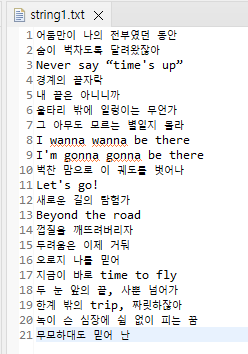api.io.object
import java.io.FileOutputStream;
import java.io.IOException;
import java.io.ObjectOutputStream;
public class Test01 {
public static void main(String[] args) {
int[] data = new int[] {4,1,9,15,11,6,2};
boolean[] flag = new boolean[] {true,true,false};
String day = "WED";
//객체 입출력
ObjectOutputStream oos = null;
try {
oos = new ObjectOutputStream(new FileOutputStream("arrays.txt"));
// CPU -> oos -> out -> target -> 실제 파일
//ObjectOutputStream을 열게 되면 기본 4byte의 출력이 일단 일어난다...
oos.writeObject(data);
oos.writeObject(flag);
oos.writeObject(day);
} catch (IOException e) {
e.printStackTrace();
}finally {
try {
if(oos != null) {
oos.close();
}
}catch(IOException e) {
e.printStackTrace();
}
}
}
}
파일내용
콘솔창에 출력되지 않음

import java.io.FileInputStream;
import java.io.IOException;
import java.io.ObjectInputStream;
import java.util.Arrays;
public class Test02 {
public static void main(String[] args) {
ObjectInputStream ois = null;
//객체 입출력
try {
ois = new ObjectInputStream(new FileInputStream("arrays.txt"));
//ObjectInputStream을 열게 되면 기본 4byte의 입력이 일단 일어난다
Object o = ois.readObject();
System.out.println(o.getClass());
System.out.println(o instanceof int[]);
int[] data = (int[])o;
System.out.println(Arrays.toString(data));
boolean[] flags = (boolean[])ois.readObject();
System.out.println(Arrays.toString(flags));
Object s = ois.readObject();
if (s instanceof String) {
System.out.println("문자열이다");
String day = (String)s;
System.out.println(day);
} else {
System.out.println("문자열이 아니다");
}
} catch(IOException e) {
e.printStackTrace();
} catch (ClassNotFoundException e) {
e.printStackTrace();
}
}
}
출력화면

import java.io.FileOutputStream;
import java.io.IOException;
import java.io.ObjectOutputStream;
import java.io.Serializable;
import java.util.ArrayList;
import java.util.List;
class Item implements Serializable {
/**
*
*/
private static final long serialVersionUID = 8324696945366661518L;
String name;
public Item(String name) {
this.name = name;
}
}
class User implements Serializable {
/**
*
*/
private static final long serialVersionUID = 1L;
// 직렬화 할 때 그 값을 체크하는 용도의 아이디값
String nick;
int exp;
int money = 500;
List<Item> i;
public User(String nick) {
this.nick = nick;
i = new ArrayList<Item>();
}
@Override
public String toString () {
return nick + "\t[" + exp + "xp, " + money + "]";
}
}
public class Test03 {
public static void main (String[] args) {
User u = new User("유저아이디");
System.out.println(u);
// close() : 클로즈 작업이 가능한 Closeable 객체에 한해 가능하므로 객체 상속을 받아야 한다
// 자동으로 close까지 가능하도록 만든 문법 ; JAVA SE 7 버전에서 나옴
try (ObjectOutputStream oos = new ObjectOutputStream(new FileOutputStream(u.nick + ".txt"))) {
oos.writeObject(u);
// java.io.NotSerializableException: api.io.object.User
// 모든 객체가 Object I/O가 가능한 것이 아니다
// byte(숫자)화가 가능한 객체들에 한해서만 가능하다 : 직렬화
// -> serializable을 상속받아 사용하면 된다
} catch (IOException e) {
e.printStackTrace();
}
}
}
출력화면

import java.io.FileInputStream;
import java.io.IOException;
import java.io.ObjectInputStream;
public class Test04 {
public static void main(String[] args) {
try (ObjectInputStream ois = new ObjectInputStream(new FileInputStream("유저아이디.txt"))){
User u = (User)ois.readObject();
System.out.println(u);
} catch (IOException | ClassNotFoundException e) {
e.printStackTrace();
}
}
}
파일 내 입력


api.io.String
import java.io.File;
import java.io.FileNotFoundException;
import java.io.FileOutputStream;
import java.io.IOException;
import java.io.OutputStream;
public class Test01 {
public static void main (String[] args) {
// 파일 내 문자열 저장
File target = new File("files", "string1.txt");
OutputStream out = null;
String text = "어둠만이 나의 전부였던 동안\r\n"
+ "숨이 벅차도록 달려왔잖아\r\n"
+ "Never say “time's up”\r\n"
+ "경계의 끝자락\r\n"
+ "내 끝은 아니니까\r\n"
+ "울타리 밖에 일렁이는 무언가\r\n"
+ "그 아무도 모르는 별일지 몰라\r\n"
+ "I wanna wanna be there\r\n"
+ "I'm gonna gonna be there\r\n"
+ "벅찬 맘으로 이 궤도를 벗어나\r\n"
+ "Let's go!\r\n"
+ "새로운 길의 탐험가\r\n"
+ "Beyond the road\r\n"
+ "껍질을 깨뜨려버리자\r\n"
+ "두려움은 이제 거둬\r\n"
+ "오로지 나를 믿어\r\n"
+ "지금이 바로 time to fly\r\n"
+ "두 눈 앞의 끝, 사뿐 넘어가\r\n"
+ "한계 밖의 trip, 짜릿하잖아\r\n"
+ "녹이 슨 심장에 쉼 없이 피는 꿈\r\n"
+ "무모하대도 믿어 난";
try {
out = new FileOutputStream(target);
} catch (FileNotFoundException e) {
e.printStackTrace();
}
byte[] data = text.getBytes();
try {
out.write(data);
} catch (IOException e) {
e.printStackTrace();
}
try {
if(out !=null) {
out.close();
}
} catch(IOException e) {
e.printStackTrace();
}
}
}
파일 내 입력

import java.io.File;
import java.io.FileNotFoundException;
import java.io.FileWriter;
import java.io.IOException;
import java.io.PrintWriter;
import java.io.Writer;
public class Test02 {
public static void main(String[] args) {
//문자열 전용 Stream을 이용하면 편하게 입출력도 가능하다
File target = new File("files","string2.txt");
Writer out = null;
PrintWriter printer = null;
try {
out = new FileWriter(target);
printer = new PrintWriter(target);
}catch(FileNotFoundException e) {
e.printStackTrace();
}catch (IOException e) {
e.printStackTrace();
}
// try {
// out.write("자바\n");
//
// } catch (IOException e) {
// e.printStackTrace();
// }
printer.append("자바\n");
printer.append("자바");
// 기존 파일 뒤에 붙임
printer.println("자바");
printer.println("자바");
printer.println("자바");
printer.println("자바");
printer.println("자바");
try {
if(out != null) {
out.close();
}
if(printer != null) {
printer.close();
}
}catch(IOException e) {
e.printStackTrace();
}
}
}
파일 내 입력

'Backend > JAVA' 카테고리의 다른 글
| JAVA 코딩 API (Application Programming Interface) - Map (0) | 2023.03.04 |
|---|---|
| JAVA 소켓프로그래밍 Network UDP (1) | 2023.03.03 |
| JAVA 코딩 API (Application Programming Interface) - charstream, singlebyte (1) | 2023.03.03 |
| JAVA 코딩 API (Application Programming Interface) - Math, System, Date, Scanner (1) | 2023.03.03 |
| JAVA 코딩 API (Application Programming Interface) - File (1) | 2023.03.02 |